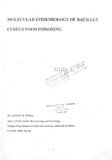| dc.description.abstract | In this study, a survey was carried out to determine the prevalence of food
poisoning outbreaks in Kenya by use of medical records and annual reports of the
Ministry of Health. Thirty seven outbreaks were reported to the Ministry of Health from
various parts of the country between 1970 and 1994, and only 13 of these outbreaks,
involving a total of 926 people, were confirmed to be due to particular aetiological
agents. The confirmed outbreaks were due to Staphylococcus aureus (5); Clostridium
perfringens (1); Clostridiun botulinum (2); Plant poisoning (3); and chemical poisoning
(2). Vehicle foods that were involved in these outbreaks included milk and milk
products (6), meat and meat products (2), cassava (2), white ants(1) and maize flour
contaminated with chemicals(2). This study indicated that the occurrence of food
poisoning outbreaks in the country is more than was recorded by the Ministry of Health
considering the high number (309,191) of food poisoning cases at were treated as
outpatients in the period 1988to 1991(Anon, 1993).
The study further explored the potential of antibiogram analysis and genetic
based techniques in identifying and establishing the toxigenicity of B. cereus strains. A
total of 153 milk samples consisting of 80 pasteurized and 73 raw were studied.
Bacillus cereus was isolated from 33(41.2 %) pasteurized and from 27(37 %) raw milk
samples. The 60 isolates were tested for production of diarrhoeal enterotoxin and ability
to hydrolyse starch. Fifty percent of them produced diarrhoeal enterotoxin and 65 %
hydrolysed starch. Although there was a strong correlation between production of
diarrhoeal
enterotoxin and hydrolysis of starch, the latter cannot be used in diagnosis of
enterotoxigenic B. cereus.
Antimicrobial susceptibility tests found B. cereus isolates to be resistant to one
or more drugs with all strains being resistant to ampicillin and susceptible to
streptomycin. The test for carriage of plasmids found 71.7 % of the isolates to harbour
between 1 and 5 plasmids with sizes ranging from 0.1 to 60 megadaltons (mDa). No
relationship was apparent between carriage of plasmids, antimicrobial susceptibility
patterns and enterotoxin production. Bacterial restriction endonuclease DNA analysis
(BRENDA) with EcoRl, Hind III, BamHl, Mb01 and Dral restriction enzymes
revealed no common BRENDA type for either enterotoxin positive or enterotoxin
negative strains.
A polymerase chain reaction (Pf'R) test detected the bceT gene in 41.1 % of the
strains, while a 741 base pair (bp) probe detected bee T gene in 44.6 % of the strains. All
the bceT gene positive strains with the peR were also positive with the 741 bp DNA
probe.
In conclusion, this study has demonstrated that plasmid profile analysis and
BRENDA are not useful in differentiating enterotoxin producing strains of B. cereus,
but can be useful techniques in differentiating individual strains of B. cereus. The study
further demonstrated that two or more diarrhoeal enterotoxins are involved in B. cereus
food poisoning, and some strains can produce more than one diarrhoeal enterotoxins.
Therefore, during investigation of a suspected B. cereus food poisoning, it would be
necessary to screen for production of diarrhoeal enterotoxin complex by use of Bacillus
cereus enterotoxin-reverse passive latex agglutination (BeET -RPLA) test kit, or
western
blot, and also detect the presence of bceT gene by peR or a probe derived from
the bee T gene.
It is suggested that peR be used to amplify whole hblA (Beecher and
Macmillan, 1990), hblC and hblD genes (Ryan et al. 1997) that code for the B, ~ and
L, proteins of hemolysin BL respectively, to delineate the gene that is specific enough
to characterize enterotoxigenic strains of B. cereus. The tests should involve direct
detection of hblA, hblC and hblD by (1) peR, and (2) probe prepared from the peR
products on a number of B. cereus strains representing both enterotoxin positive and
negative strains. | en |

